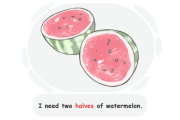Fractions, Decimals and Percentages

What Are Fractions?
Fractions are a way of expressing a part of a whole or a ratio of two numbers. A fraction consists of two numbers separated by a horizontal or diagonal line.
Why Do We Use Fractions?
Fractions are used to refer to a portion or part of something else but not the whole amount. Fractions are made of an ordinal and a cardinal number.
Different Parts of a Fraction
Here are the different parts of a fraction:
numerator: is placed above the dividing line and indicates the parts that are selected. It is always a cardinal number
dividing line: a horizontal or diagonal bar which separates the parts of a fraction.
denominator: is placed under the dividing line and represents the total number of equal parts in the whole. It is always an ordinal number.
Fractions: Types
There are four different types of fractions:
Unit fractions
Proper fractions
Improper fractions
Mixed fractions
Unit Fractions
This is when the numerator is '1' and we read the denominator in a singular form.
Fractions | Written Form |
|---|---|
1/2 | One half or a half |
1/9 | One ninth |
1/3 | One third |
1/4 | One forth or a quarter |
Exceptions
when the denominator is 2, the fraction is called a half (not a 'second')
when the denominator is 4, the fraction is called a quarter (not a 'fourth')
You have half an hour to finish your homework.
I need two halves of watermelon.
'Halves' is the irregular plural form of 'half.'
Proper Franctions


When the numerator of a fraction is bigger than '1', the denominator is read in plural form.
Fraction | Written Form |
|---|---|
3/7 | Three sevenths |
2/3 | Two thirds |
2/5 | Two fifths |
6/8 | Six eighths |
Improper Fractions
This is when the numerator is bigger than or equal to the denominator.
Fraction | Written Form |
|---|---|
4/3 | Four thirds |
5/4 | Five fourths |
3/4 | Three fourths |
6/5 | Six fifths |
Mixed Fractions
This is when there is a whole number next to a unit or proper fraction. To say the number, we say the whole number first followed by 'and' and finally the fraction number.
6 3/5 | Six and three fifths |
2 3/4 | Two and three fourths |
4 1/2 | Four and a half |
Fraction | Written Form |
|---|---|
1/2 | a half |
1/4 | a quarter |
I need to cut a board that is two and three-fourths inches thick.
I walked for four and a half miles this morning.
Warning
Do not mix figures and words.
a two-thirds decrease (Not 'a 2 thirds decrease')
What Are Decimals?
Numbers smaller than one can be shown by decimals. In English, decimal numbers are separated by a decimal point and not a comma.
How to Read Out Decimals?
the numbers after the decimal point are read out digit by digit, not as a compound number.
Decimal number | Written form |
|---|---|
0.2 | Zero point two |
0.25 | Zero point two five |
1.032 | One point zero three two |
12.025 | Twelve point zero two five |
12.006 | Twelve point zero zero six |
Tip!
Remember that in English, we use a decimal point for decimal numbers and a comma to separate thousands.
12.025
twelve point zero two five
12,025
twelve thousand and twenty five
Warning
We never use hundred and thousand after the decimal point.
What are Percentages
Percentages are easy and commonly used in our everyday conversations. A percentage is a number or ratio that expresses a fraction of 100 with the symbol '%'. To read them, we say the number and then the word percent. Check out some examples:
Percentages | How to Say |
|---|---|
2% | two percent |
35% | thirty-five percent |
50% | fifty percent |
70% | seventy percent |
90.5% | ninety point five percent |
100% | a/one hundred percent |
We can also turn percentages into decimal numbers:
Percentage | In decimal number |
|---|---|
50% | 0.5 |
24% | 0.24 |
2.4% | 0.024 |
Comments
(0)